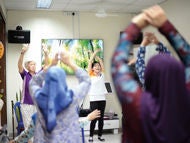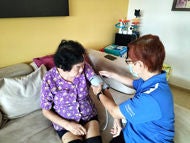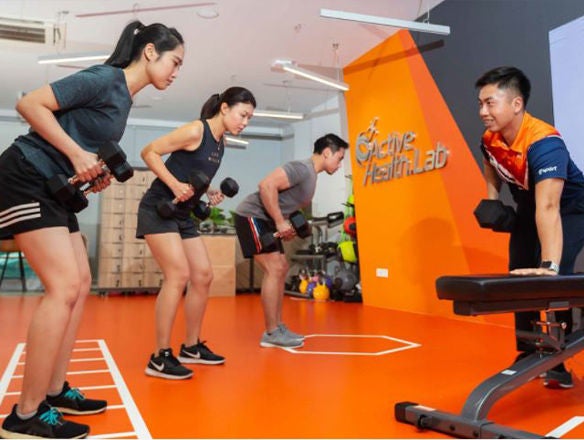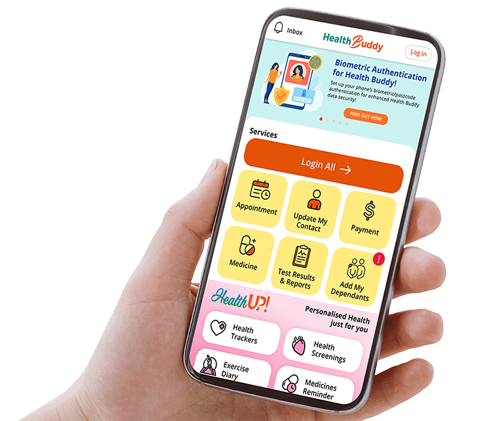SingHealth Institutions will NEVER ask you to transfer money over a call. If in doubt, call the 24/7 ScamShield helpline at 1799, or visit the ScamShield website at www.scamshield.gov.sg.
By Valissa Yap
Walking may seem like the simplest of actions, but for post-operative cardiac patients in recovery, each step carries risk. An often-overlooked factor – patients’ footwear – presents a significant safety concern in fall prevention and ensuring a successful recovery.
We find out how Team Smart Steps, a collaborative effort from Cardiac Physiotherapy and Rehabilitation Services (CPRS) and Nursing, tackled the problem at its source.
Addressing the Hidden Safety Gap
The team’s initial assessment revealed complex root causes: patients often overlook footwear due to knowledge gaps, financial constraints and information overload during pre-surgery preparation.
“Patients often choose easy-to-wear shoes out of convenience,” shared Kwek Swee Sin, Senior Physiotherapist from Cardiac Physiotherapy and Rehabilitation Services (CPRS) and a member of Team Smart Steps. “Some patients have difficulty retaining secondary information, while some are overwhelmed by critical details to remember before a major surgery and may not prioritise footwear. There are also some who do not realise the importance of proper footwear.”
Preliminary observational studies revealed a concerning finding – nearly half of surveyed patients did not wear proper footwear during their hospital stay. This highlighted a serious, yet preventable, safety gap. In an internal assessment, findings revealed that 61% of patients were unable to identify proper footwear, and 13% did not agree that proper footwear can help prevent falls.
The Path to Safety
To bridge this safety gap, the team implemented a three-pronged solution, strategically engaging staff and patients through education and standardisation of care.
Firstly, the team focused on staff education by integrating bite-sized learning into weekly huddles. Nurses were taught the importance of proper footwear and assessing them based on key features such as good heel cup, low and wide heels with rounded edges, and a wide and deep toe box. These sessions served as an essential platform in ensuring consistent knowledge dissemination across all shifts.

Integrating footwear safety education into nurses’ weekly huddles to reinforce learning.
Secondly, the teams strategically targeted the Pre-Admission Test (PAT) as a key opportunity to educate both patients and their caregivers on the importance of bringing suitable shoes during their admission. “We found that patients are more likely to comply when they understand the rationale of bringing appropriate shoes during their hospital stay,” explains Senior Staff Nurse (SSN) Yusniyati Bte Samsudin from Cardiac Clinics and member of Team Smart Steps, whose work duties include educating patients prior to their hospital admission at the PAT clinic.

Nurse educating patient and their caregivers on proper footwear at the Patient Admission Test (PAT) clinic.

Posters on safe footwear in wards and clinics serve as visual reminders to staff and patients.
Lastly, the team implemented a Safe Shoe Checklist, adapted from established clinical guidelines. The checklist served as a reference for assessing footwear during admission and physiotherapy sessions, eliminating guesswork and ensuring a standardised and systematic approach to patient safety.
Transforming the Patient Journey
Results after the implementation were encouraging with remarkable improvements in staff awareness and knowledge – 100% of staff were able to identify appropriate footwear and understand its role in fall prevention, compared to 76% previously! Likewise, patients who brought proper footwear increased from 54% to 63%, while patient awareness in identifying proper footwear went up dramatically from 39% to 98%.
“Since the implementation of patient education materials and with the support from colleagues, we observed a drastic reduction in fall incidents related to footwear during inpatient stays and post-operative physiotherapy sessions,” shares Chen Hebin, Senior Manager, CPRS and facilitator of Team Smart Steps.
Through this thoughtful initiative, the nursing and physiotherapy teams demonstrated how addressing a seemingly simple issue of patients’ footwear, can have profound implications for safety, mobility, and overall care quality. Moving forward, the team plans to create patient education videos and collaterals to reinforce the message to patients and caregivers during PAT appointments. In the pipeline is also the development of e-learning modules for staff to complete at their own convenience, further emphasising the importance of wearing proper footwear.

Team Smart Steps team members and facilitator from L-R: Kwek Swee Sin, Senior Physiotherapist, CPRS; Nurse Clinician (NC) Yang Yang, Ward 44; SSN Yusniyati Bte Samsudin, Cardiac Clinics; NC Siti Fidawati Binte Jasman, Ward 56; Chen Hebin, Senior Manager, CPRS. Not pictured: Muhammad Isa Bin Mohd Musa, Physiotherapist, CPRS.
Keep Healthy With
© 2025 SingHealth Group. All Rights Reserved.




















